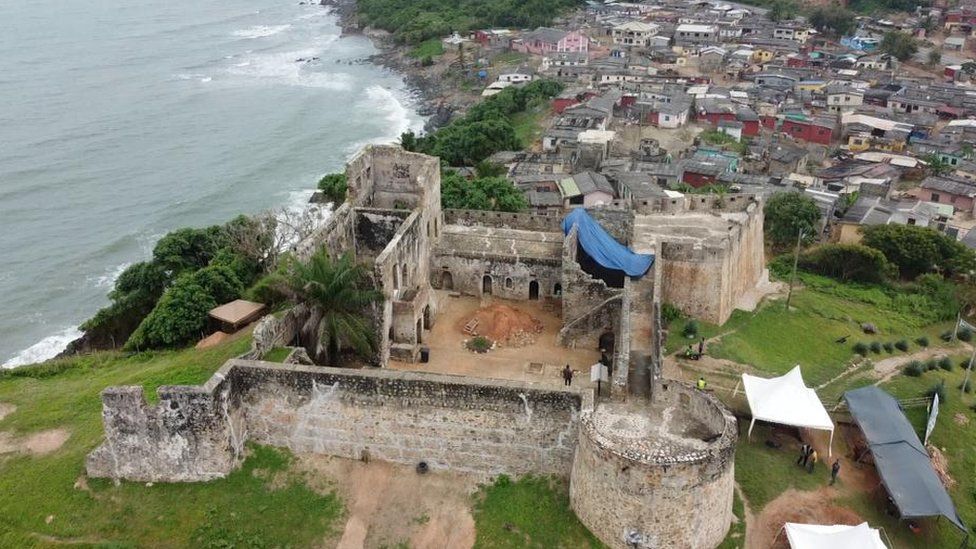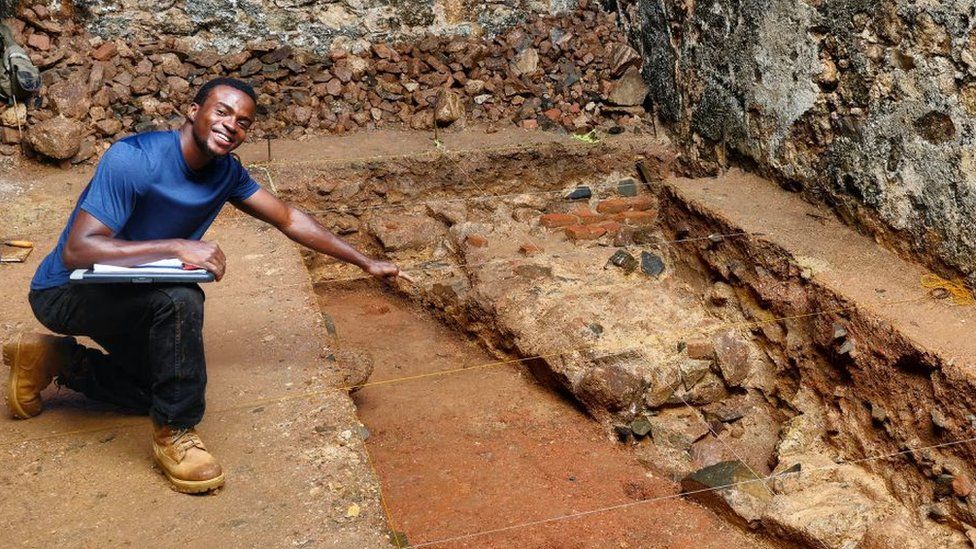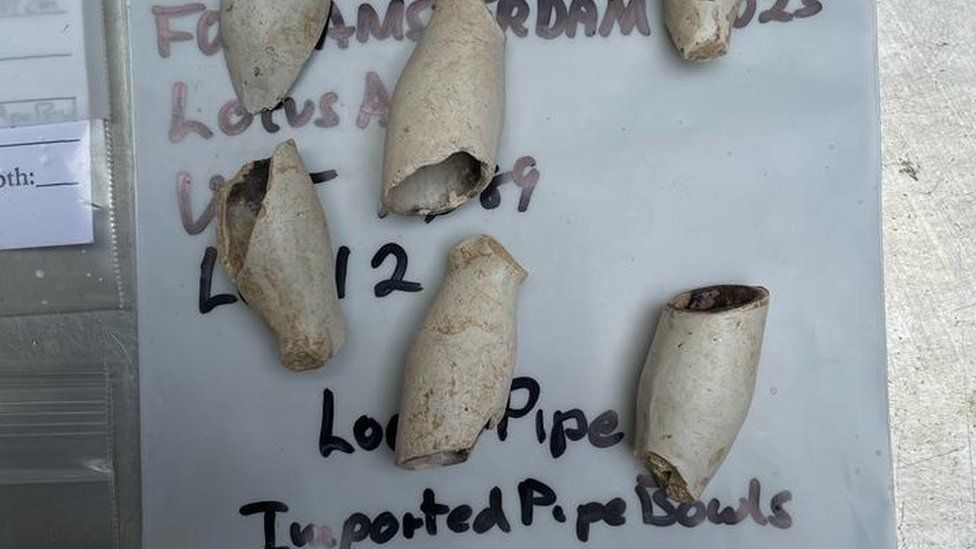Taking care, archaeologist Christopher DeCorse spreads the rare artefacts out on a makeshift table next to the dig site.
A gunflint (used in old-fashioned guns), tobacco pipes, broken pottery and the jawbone of a goat are carefully laid out. These discarded fragments, unearthed from centuries of compacted soil, offer clues to a lost past.
“Any archaeologist who says they are not excited when they find something are not being entirely truthful,” the professor from Syracuse University in the US says with a broad smile.
These remnants point to the existence of “the first English outpost established anywhere in Africa”, he argues.
The archaeologist is standing in the ruins of Fort Amsterdam, speaking above the wind and roar of the Atlantic Ocean waves hitting Ghana’s coastline.
Inside that fort are what are thought to be the remains of an older fort – Kormantine – long-lost under the earth, which the professor’s team are gradually excavating with brisk activity.

They are methodically combing through distinct layers of soil and stones with soft-bristle brushes and trowels. The disturbed soil removed from the trenches is carefully sieved.
A canopy protects the team and the site from the weather and despite the intense sun and the occasional shower, the archaeologists’ work continues.
Ancient maps had referred to a Fort Kormantine in that area, for example the name of the nearby town, Kormantse, is clearly related. In addition, another version of the name, Coromantee, was given to some of the enslaved people in the Caribbean thought to have been transported from this place and later known for slave rebellions.
But where exactly the fort was located remained a matter of speculation, which may have now been brought to an end.
Dating back to the 17th Century, Fort Kormantine sat on the Atlantic coast just at the time when Europeans started shifting their interest from the trade in gold to the trade in humans.
It was a pivotal moment in the history of their involvement in Africa that would have a profound effect on the continent.
The discovery by the team of archaeologists may shed some light on the lives of those early traders and what they were doing, as well as those who were sold and the impact on the community around them.
Ghana’s coastal fishing towns, known for their colourful boats and the melodies sung by the fishermen, remain scarred by a past of European exploitation and human cruelty.
The slave forts dotted along what was called the Gold Coast are a looming reminder of that past.
Hundreds of thousands passed through them before being transported in horrific conditions across the sea.
Fort Kormantine – built by the English in 1631 – was one of the earliest places where that journey started.
It began life as a trading post for gold and other items like ivory.
The slave trade only began from there in 1663 when King Charles II granted a charter to the Company of Royal Adventurers of England Trading into Africa (later the Royal African Company). He gave it monopoly rights over the trade in human beings.
It was only in English hands for another two years before the Dutch seized it but Fort Kormantine played a key role in the initial stages of the slave trade.
It served as a warehouse for the goods that were used to buy slaves. It was also a brief holding point for those who had been kidnapped in different parts of West Africa before being shipped to the Caribbean to work in plantations to develop the sugar economy.
“We don’t have that many details on exactly what these early outposts of the slave trade looked like, which is one of the things that make uncovering the foundations of Fort Kormantine interesting,” Prof DeCorse says.
After capturing the fort, the Dutch built Fort Amsterdam on the same site, which is why its exact location could not be pinpointed, especially after it became a United Nations-recognised World Heritage Site, making excavation difficult.
But initial digs in 2019 in and near Fort Amsterdam, which turned up some early 17th Century artefacts, suggested where it might be.
Archaeologists returned earlier this year and began further searches.

At first there was some disappointment as they started by finding a lot of plastic items that must have been dropped more recently. But then Nigerian graduate student Omokolade Omigbule uncovered a stone that Prof DeCorse identified as part of a bigger structure.
“It was mind-blowing, seeing first-hand the remnants, the footprints of an actual building subsumed under a new fort,” says the student from the University of Virginia.
“Seeing the imprints of these external forces in Africa first-hand and being a part of such a dig takes me back a few hundred years, it feels like I was there.”
As the excavations continued, they uncovered a six-metre-long (20ft) wall, a door post, foundations and a drainage system made of red brick.
All these indicate an English presence pre-dating the Dutch fort.

Returning to the display of artefacts in neatly labelled zip-lock bags, Prof DeCorse points out the rusty gunflint, which he says was in use in England in the early 17th Century.
The pipes with their small bowls where the tobacco was placed “is also very distinctive of the time that we are talking about here”, the professor says, adding that over time the bowls got larger as tobacco became cheaper and more readily available.
Pre-empting the question about why the jawbone of a goat is important, Prof DeCorse suggest that it is proof of how the English occupants may have domesticated local animals as an alternative source of protein despite being on a coastline where there were fish in abundance.
Archaeology is painstaking work. Each fragment of the past it throws up needs to be interrogated and interpreted.
But in some ways, the hard work has only just begun. Archaeologists will spend the next three years trying to unravel the gamut of Fort Kormantine – its architecture, look and feel – which should in turn reveal its true significance.



